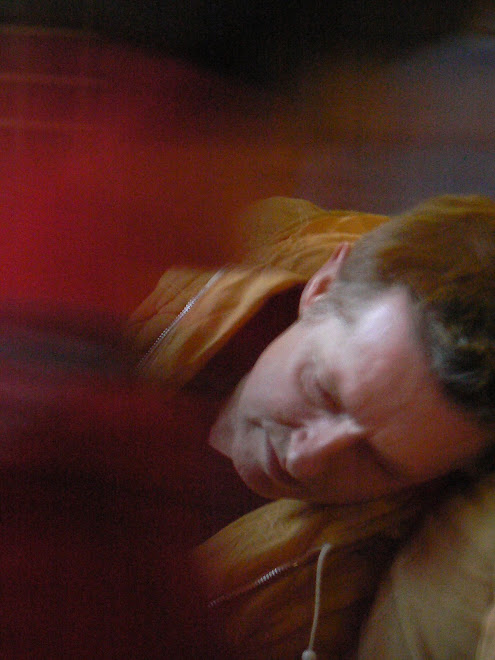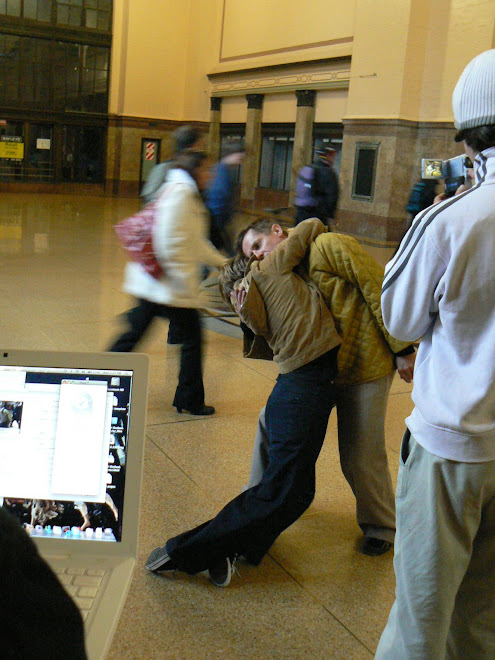Subscribe to:
Post Comments (Atom)
skip to main |
skip to sidebar


Concourse clock, rush hour - Wellington Railway Station. Cam Fiona Baker


Duet in the Concourse. Cam Fiona Baker

Leaving 1. Cam Fiona Baker

The witness ... Cam Fiona Baker
Followers
'IN THE COMPANY OF STRANGERS'
Abstract Title:
In the Company of Strangers - Negotiating the parameters of Indeterminacy; a study of the Roaming Body and Departure in Urban Spaces
Abstract:
This performance-based project scrutinizes Indeterminacy as a mediating force impinging upon our behaviour and its subsequent impact on the nature and constituency of engagements and dialogue between people in selected urban spaces. Concepts centring on the dynamics of temporality and embodiment in departure are being investigated in both First Life and the Multi User Virtual Environment, Second Life as two locations on the same world surface of the Real.
My research-practice posits the formation of a new Urban Myth: Experienced through the vehicle of the Roaming Body, our meetings and encounters with people frequently manifest as disjunct mis-communiqués and dis-engagements. I am asserting that this is due to the inevitability in our existence of indeterminacy acting as a significant governing factor in the articulation of our relations with others, reinforcing our description as time-based entities traversing the passage of the everyday. I maintain that this is evidenced in us through the occurrence of a continual, pre-emptive state of departure. Indeterminacy implies motion and emerges, as Massumi asserts, through ‘… an unfolding relation to its own nonpresent potential to vary …’. We, as humans, are constantly being drawn away – always either approaching or embracing involuntarily, a state of ‘Leaving’ which co-mingles with and unerringly erodes our efforts to stay engaged with another in the here and now.
In my research/practice, which underpins the concepts in
this masterate, interventionist inscriptions are being used to prompt and interrogate the constituents of encounters and departures in designated public places. Experiential movement frameworks employed are informed by the discipline of Contact Improvisation Dance and Authentic Movement. The working process is being documented using a range of video narrative.
Massumi, B. (2002). Parables for the Virtual: Movement, Affect, Sensation. Duke University Press, Durham & London, (p.5).
Def: 'The Roaming Body' - the body as entity which can never be fully committed to a set position or location in space and time (Mike Baker Feb 09)
Title image: Dancers - Mike Baker and Sylvie Haisman, Camera - Fiona Baker
In the Company of Strangers - Negotiating the parameters of Indeterminacy; a study of the Roaming Body and Departure in Urban Spaces
Abstract:
This performance-based project scrutinizes Indeterminacy as a mediating force impinging upon our behaviour and its subsequent impact on the nature and constituency of engagements and dialogue between people in selected urban spaces. Concepts centring on the dynamics of temporality and embodiment in departure are being investigated in both First Life and the Multi User Virtual Environment, Second Life as two locations on the same world surface of the Real.
My research-practice posits the formation of a new Urban Myth: Experienced through the vehicle of the Roaming Body, our meetings and encounters with people frequently manifest as disjunct mis-communiqués and dis-engagements. I am asserting that this is due to the inevitability in our existence of indeterminacy acting as a significant governing factor in the articulation of our relations with others, reinforcing our description as time-based entities traversing the passage of the everyday. I maintain that this is evidenced in us through the occurrence of a continual, pre-emptive state of departure. Indeterminacy implies motion and emerges, as Massumi asserts, through ‘… an unfolding relation to its own nonpresent potential to vary …’. We, as humans, are constantly being drawn away – always either approaching or embracing involuntarily, a state of ‘Leaving’ which co-mingles with and unerringly erodes our efforts to stay engaged with another in the here and now.
In my research/practice, which underpins the concepts in
this masterate, interventionist inscriptions are being used to prompt and interrogate the constituents of encounters and departures in designated public places. Experiential movement frameworks employed are informed by the discipline of Contact Improvisation Dance and Authentic Movement. The working process is being documented using a range of video narrative.
Massumi, B. (2002). Parables for the Virtual: Movement, Affect, Sensation. Duke University Press, Durham & London, (p.5).
Def: 'The Roaming Body' - the body as entity which can never be fully committed to a set position or location in space and time (Mike Baker Feb 09)
Title image: Dancers - Mike Baker and Sylvie Haisman, Camera - Fiona Baker
‘What is the appropriate behaviour for a man or a woman in the midst of this world, where each person is clinging to his piece of debris? What`s the proper salutation between people as they pass each other in this flood?’
Buddha.
Human Givens. vol 14, (3) Human Givens Publishing Ltd, East Sussex, England, UK
Buddha.
Human Givens. vol 14, (3) Human Givens Publishing Ltd, East Sussex, England, UK
Blog Archive: New discussion topics related to the above abstract:
-
▼
2008
(84)
-
▼
May
(21)
- Expressing the Duende in Meetings and Engagements ...
- Station 2 poignancy in Leaving
- Station 3 poignancy in Leaving
- Station 4 poignancy in Leaving
- Expressing the Duende in Meetings and Engagements ...
- Concourse roll
- Street duets
- No title
- No title
- Friends parting
- No title
- Strangers meeting in the Street
- No title
- No title
- Leaving and the Duende
- No title
- No title
- No title
- No title
- No title
- No title
-
▼
May
(21)
About Me

- Wild Swimming Heart
- Nelson, South Island, New Zealand
- Please check my blog and profile ... you will also find images of my work on flickr.com, under: http://www.flickr.com/photos/nomads_hat/ and my videos under RolloKohime at YouTube
Links List / Please find more images at the bottom of this post
- -empyre- soft-skinned space
- alansondheim.org
- AlienNation Co
- dance-tech.net
- danssansjoux.org
- Dr Donna Haraway, A Cyborg Manifesto: Science, Technology and Socialist-Feminism in the late Twentieth Century, in Simian, Cyborgs and Women: The Reinvention of Nature (New York; Routledge, 1991
- Dr Donna Haraway, When Species Meet, University of Minnesota Press, 2008
- Henri Bergson, Mark Hansen, (bodies in code), microflicks, dad.project, leftluggage, davidandjacob, slightly.net, hyperchoreography, throwdisposeablechoreography, Contact Quarterly, Text and Performance Quarterly, Liminalities, skellis.net, Body Space Image, Jumpcut, Brian Massumi, Marc Augé, T`ai Chi Ch`uan, Body Space and Technology Journal, Slightlymoving, Proximity, Saatchi-gallery.co.uk, Len Lye, Rafael Lozano-Hemmer
- Michel Serres, The Parasite, University of Minnesota Press, 2007
- Scott Draves.com
- Second Life.com
- subtletechnologies - Alan Sondheim
- touchcompass.org.nz
- Turbulence.org
- YouTube (people and blogs - strangers), Discourse off the Walls - Authored Indeterminacies, Peter Lorre,
In the Company of Strangers

Concourse clock, rush hour - Wellington Railway Station. Cam Fiona Baker
ICS. Red Station Dance
ICS. Todd Cochrane and Grant Corbishley streaming our dance from the station onto the Net
Duet in the Concourse. Cam Fiona Baker
In the Company of Strangers

Leaving 1. Cam Fiona Baker
In the Company of Strangers

The witness ... Cam Fiona Baker


1 comment:
I have done quite a lot of work on this sketch since I first posted it. Changes include, applying 'Pleasantville' in Final Cut, an effect which allows you to isolate a chosen person or object through colouring the selected subject/object and desaturating everything else around it. The technique is based on the film of that name where this occurred. I applied this only in part to reduce the warmth of the surrounding while retaining some of the warmth of our dancing clothing/personna. I then added a 'brightness/contrast' filter to bring in a little more darkness. I have also cut out the end sequence where Sylvie says goodbye on the train. This struck me as a little too happy and carefree (although pathos can be present because of, rather than without this). I slowed down our hands parting and slowed down Sylvie waving through the train windows - moments which although rather stereotypical, furnish me with the chance to have a good look at how these sequences work. Also, I am working in the territory of the stereotypical - it is what I do with it which, I think, will count. I have added some audio to the very end of the piece too. I will be adding this to my next, 'Workshopping' post. Station 4 gives me more narrative to work with. It combines the intimate hand-held camera-sight with distance cut-aways, Sylvie speaking, wiping her nose and creates a story which is, although traditional in its linear handling, is nevertheless, believable.
I will be exploring some non-linear narrative soon, but the material so far, to some extent, is giving me a departure point from which to extend my thinking into more 'flicker-thought' peripheries - image capture of fleeting moments out of the corner of the eye, which sticks on the retina for a while. The moments are no less meaningful for being disassociated from linear story-telling.
Post a Comment